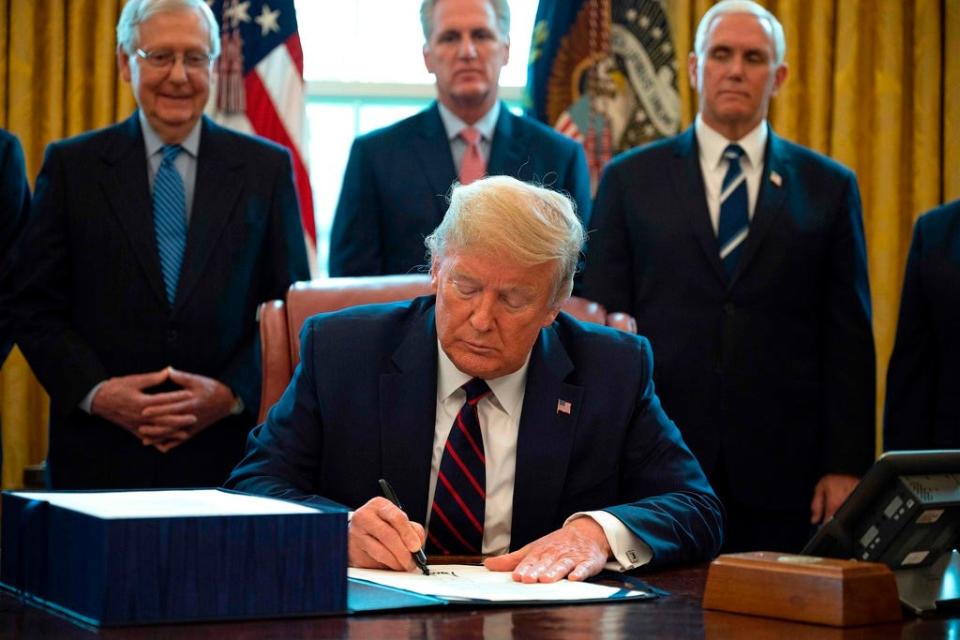Fighting the coronavirus pandemic: The economic front
The novel coronavirus (COVID-19) pandemic has shut down entire portions of the U.S. economy and is crushing financial markets. Most forecasters expect this crisis to surpass the depths of the 2007-09 recession and, as a result, policymakers scrambled to respond. The White House and Congress recently passed a $2 trillion relief package, while the Federal Reserve is planning to invest up to $4 trillion in the economy.
These responses are extraordinarily large in dollar terms and understandably leave some observers aghast. This level of support, however, is not unprecedented when viewed from the right perspective and is arguably warranted given that the U.S. economy has been effectively put into an induced coma.
The proposed government outlays can be best thought of as part of a mass mobilization for war, just like the country did for World War II. Back then, the war was against foreign powers, and we mobilized factories, machines and troops to fight a physical foe.
Today, the war is against a virus or an “invisible enemy,” as President Donald Trump has described. We’re mobilizing our health care industry and the ability for people to stay home in order to fight.
Government outlays exceeded a whopping 40% of the economy during World War II. This time, the projected government expenditures could reach over 30%. This is far larger than the normal 20% but not unprecedented compared with the last great war.
Economic front line
This fight against the novel coronavirus, like World War II, is also a two-front war. The first front is the public health battle against the virus. The second front is saving the economy from a debilitating wave of bankruptcies and liquidations as businesses are shut down and workers are sent home. This lockdown amounts to an economically induced coma, and most of new government funding is a form of life support to make it through this ordeal.
This economic life support package includes direct cash transfers and unemployment insurance sent to households, grants and loans given to businesses, backstops and investments directed to credit markets, and more. These programs, though far from perfect, are driven by an overarching framework to maintain household and business income so that they can make their preexisting financial obligations, such as mortgages and payroll.
After pandemic ends: U.S. needs Recovery Authority to speed economic rebound
Even though new goods and services will be scarcer and more expensive over the next few months, maintaining the expected dollar incomes is important to avoid any spillover effect that could ripple through the economy such as insolvency or bankruptcy. Proposals for mass debt forbearance during the crisis also would help to avoid such secondary effects. All of these approaches are warranted for an economy put into lockdown so that it can quickly recover once the public health battle is over.
How can we fight
A powerful way to make these efforts more effective is for the government to announce that it’s targeting the total dollar income size of the economy. That is, the government would state that all of its endeavors are to keep the $23 trillion economy on its trend growth path. This target would help focus the efforts of the White House, Congress and the Fed around an explicit goal. It would also provide a powerful signal to the public.

Normally, the Fed is the institution that announces such targets and should do so here. It is nimbler than other government agencies in applying pressure to the economy and can use the total dollar income target to help avoid a depression now, but also an inflationary boom later. The Fed’s abilities, however, are limited by law: It can’t make direct cash payments to the public. Congress could consider giving this ability to the Fed in limited circumstances so that it can more effectively implement the total dollar income target in times of crisis like the present one.
The Editorial Board: The right way forward on coronavirus
We are in the fight of our lives in the war against COVID-19. As St. Louis Federal Reserve President James Bullard recently said, the new government expenditures directed toward this fight should not be viewed as a stimulus package drawn up for an ordinary recession. Rather, they should be viewed as life support for an economy put into an induced coma in the midst of war. This framing better prepares us for the journey ahead and makes clear what is at stake.
Let’s hope all Americans rise to this occasion just as the previous generation did in World War II.
David Beckworth, a senior research fellow with the Program on Monetary Policy at the Mercatus Center at George Mason University, is a former international economist at the U.S. Department of the Treasury. Follow him on Twitter: @DavidBeckworth
You can read diverse opinions from our Board of Contributors and other writers on the Opinion front page, on Twitter @usatodayopinion and in our daily Opinion newsletter. To respond to a column, submit a comment to letters@usatoday.com.
This article originally appeared on USA TODAY: Fighting the coronavirus pandemic: The economic front

